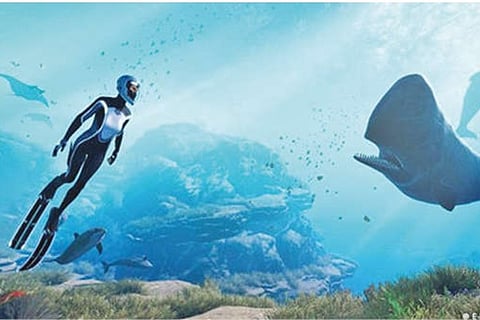

Chennai
Mirai is the animated protagonist in Beyond Blue, an ocean adventure video game set in the near future. Inspired by the BBC Blue Planet II nature documentary, and using some footage from the British broadcaster, the game is designed to make players care about the marine world.
Both Mirai and the deep she is exploring are based on insights from three real-life experts active in the field of marine biology, oceanography and ocean exploration. Alan Gershenfeld, a co-founder of E-Line Media, the US game publisher and developer behind Beyond Blue, said he wanted to create a strong protagonist who would serve as a role model for players to connect with and look up to. “The more gamers care about the ocean, the more they want to explore the ocean, avocational or as a career,” he told DW. “I believe, that’s a key step towards ocean preservation.” According to a UN report, environmental video games like this one might be the next step in raising environmental awareness. Around 2.6 billion people, or one in three across the globe, play video games. And the industry generates annual revenue of over $140 billion — more than Bollywood, Hollywood and recorded music sales combined.
The report describes the reach, creativity and problem-solving ethos of the gaming industry as an “untapped resource for encouraging engagement in environmental issues.”
While nature has long featured in virtual landscapes, game design is now shifting towards specific environmental issues.
In Bee Simulator, for example, players become bees, buzzing through the microworld of their declining population — the fate of the family lies on the player’s wings when people decide to destroy the tree that holds the hive. The survival game Endling, coming out later this year, is told through the eyes of Earth’s last remaining mother fox, trying to protect her cubs in a world destroyed by humans.
Likewise Minecraft — which has sold 200 million times in all formats — has a Climate Hope City map that invites players to explore real-world green solutions like vertical farms and an energy generator that can produce different types of green energy.
More recently, Sims, the life simulation game that first emerged in 2000, has released an Eco Lifestyle expansion pack where players can run a clean-water and recycling project or build wind turbines on rooftops to decrease their carbon footprint. True eco-warriors can even go dumpster diving. Alenda Chang, author of the book Playing Nature: Ecology in Video Games says players can learn about the human impact on the environment by witnessing different scenarios of how their actions impact their world.
“Games force us to interact with the system, and they produce feelings,” Chang said. “Players do things and can feel guilty because of their choices. Or they can feel the flash of success when things work out in the game.” Chang attributes the trend toward more eco-based storylines to both the needs of younger players and the priorities of new designers. “Young people see climate change as something that informs who they are as individuals,” she said. “Organically what’s happening is that this new wave of game designers is bringing these interests with them.”
This article was provided by Deutsche Welle
Visit news.dtnext.in to explore our interactive epaper!
Download the DT Next app for more exciting features!
Click here for iOS
Click here for Android